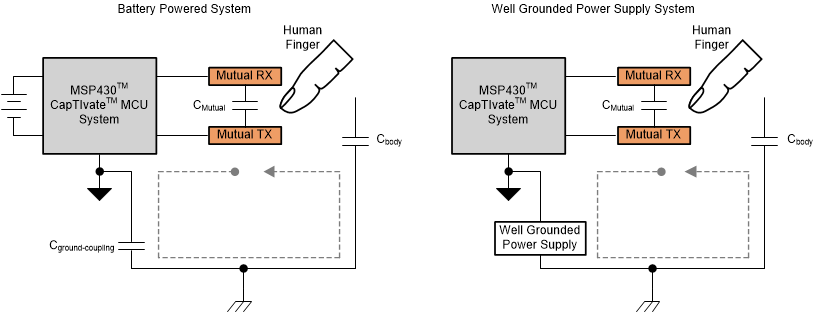TIDUE90 July 2018
- Description
- Resources
- Features
- Applications
- Design Images
- 1System Description
- 2System Overview
- 3Hardware, Software, Test Requirements, and Test Results
- 4Design Files
- 5Software Files
- 6Related Documentation
- 7About the Author
2.4.4 Power Supply Grounding Effect
For a capacitive touch system, the measurement result is impacted by all the elements in the whole capacitive loop so how the system is connected to the earth ground can significantly affect the measurement results.
In typical battery-powered scenarios (see Figure 11), the system is not directly connected to earth ground. It is coupled to earth ground with free space coupling. And the further the system is away from the earth ground the weaker the coupling between the system and earth ground which means the smaller Cground-coupling. From the mutual mode capacitive touch sensing perspective, the weak coupling minimize the capability of human finger touch to reduce the mutual capacitance Cmutual which result in lower touch sensitivity.
In typical scenarios with a well grounded power supply (see Figure 11), the system is either directly connected to earth ground or strongly coupled to earth ground. From the perspective of mutual capacitance touch sensing, the strong coupling increases the reduction of the mutual capacitance (Cmutual) when a human finger touches the surface, which results in higher touch sensitivity.
The sensitivity difference between a battery-powered system and a wall-powered system is more significant in scenarios with liquid present. This is because liquid has higher dielectric constant than air, so liquid on top of the area between the RX and TX increases the electric field coupling between RX and TX, which increase the capacitance, Cmutual. With larger Cmutual, the reduction of sensitivity in a battery-powered system is more significant.
To improve the performance for a battery-operated system with heavy continuously flowing liquid, the system must increase the coupling to earth ground. A number of methods can improve the system coupling to earth ground. For example, enlarging the physical size of the hardware system, adding a large ground plane to the system, and placing the system close to physical earth ground surface like a wall or the floor.
The measurement data for both the battery-powered scenario and the wall-powered scenario are included in Section 3.2. The measurement data in this document for a battery-powered scenario demonstrates the sensitivity reduction but each system is designed differently. First, this reference design is only a reference for the human-machine interface subsystem and not for the whole system. Second, as previously described for a battery-powered system, the capacitive touch sensitivity is highly depend on the system coupling to earth ground.
 Figure 11. Battery-Powered and Well Grounded Power Supply Capacitive Touch Systems
Figure 11. Battery-Powered and Well Grounded Power Supply Capacitive Touch Systems